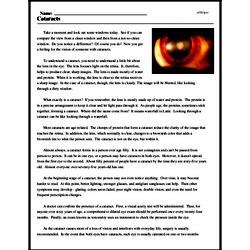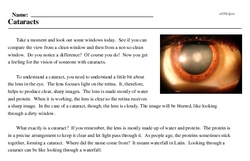Cataracts
Take a moment and look out some windows today. See if you can compare the view from a clean window and then from a not-so-clean window. Do you notice a difference? Of course you do! Now you get a feeling for the vision of someone with cataracts.
To understand a cataract, you need to understand a little bit about the lens in the eye. The lens focuses light on the retina. It, therefore, helps to produce clear, sharp images. The lens is made mostly of water and protein. When it is working, the lens is clear so the retina receives a sharp image. In the case of a cataract, though, the lens is cloudy. The image will be blurred, like looking through a dirty window.
What exactly is a cataract? If you remember, the lens is mostly made up of water and protein. The protein is in a precise arrangement to keep it clear and let light pass through it. As people age, the proteins sometimes stick together, forming a cataract. Where did the name come from? It means waterfall in Latin. Looking through a cataract can be like looking through a waterfall.
Most cataracts are age-related. The clumps of protein that form a cataract reduce the clarity of the image that reaches the retina. In addition, the lens, which normally is clear, changes to a brownish color that adds a brownish tint to what the person sees. The cataract is not on the eye, but within it.




